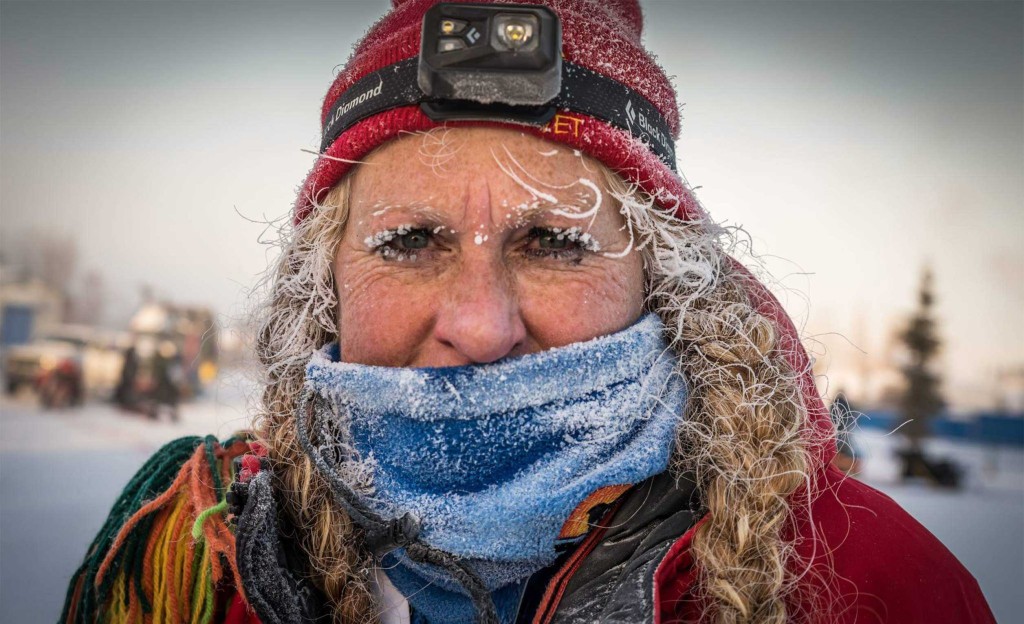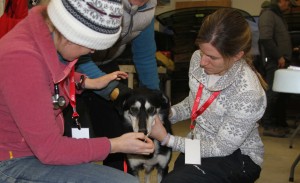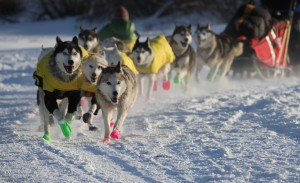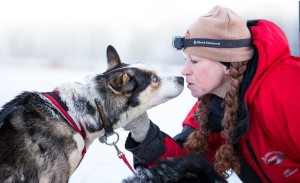Yukon lures grads to work as sled dog race vets
Temperatures of -50, minimal sunshine, less sleep and no pay—who wouldn’t want to spend the first half of February massaging dog feet along the Yukon Trail?
Yet Noel (Plaetz) Kubat, a 2005 animal science graduate, said, “I’m going to keep going back as long as I can.†She was anticipating her fourth year as a veterinarian for the 1,000-mile Yukon Quest International Sled Dog Race, which started Feb. 1, 2020.
Greta (Heismeyer) Krafsur, a 1991 grad, has worked as a Yukon Quest veterinarian since 2015. “It’s one of the most beautiful experiences I’ve ever had,†she said.
The alumni found their way to the Great Northern wilderness independently, but have become fast friends. “We first met in 2016 while serving as race vets. It turned out we had more in common than being veterinarians and loving Alaska. We were both farm kids and had an exceptional love for cattle and the Jackrabbit nation,†Krafsur said.
Each race draws a dozen veterinarians, a couple vet techs and a couple vet school students who each pay their own way to the frozen territory.
Krafsur’s day job, since January 2019, is an assistant professor, pathologist and researcher at the Animal Disease Research and Diagnostic Lab on campus. Kubat is a major in the U.S. Army and has been an active duty military veterinarian since 2009. In August 2019, she began a food science doctoral program at the University of Kentucky in Lexington.
Alums bonded on race trail
One year, Krafsur and Kubat were on the same vet team. Other years they have followed each other along the race checkpoints.
Kubat, whose military travels have taken her from New York to Fairbanks, Alaska, to Bahrain and then Fort Knox, Kentucky, said she finds herself “naturally drawn to people from Minnesota and South Dakota. (Yes, the long “o†in the state’s name does pinpoint a native.) We both like beef cattle. It was an easy friendship to establish.â€
Friendships also are what keep the women going back.Â
Krafsur, an Estelline native, said, “It’s like a family. From the race vets to the race officials to the mushers to their families, it’s really a tight-knit family even though you only see them once a year. The rookie mushers, to see them develop confidence as they go through the race, it’s really neat to be a part of that.â€
Kubat, who grew up in Wabasso, Minnesota, east of Marshall, echoed Krafsur’s reason for returning: “The people I’ve met.
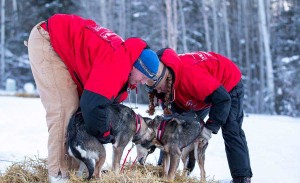
Greta Krafsur, right, and another race vet
check the condition of a couple huskies
during a mandatory rest stop.
“It’s kind of a reunion every year. While there are always new people, you get to see a lot of the same people year in and year out. I’ve met people from all over the United States, Canada and Europe working as veterinarians, veterinary technicians, mushers, race staff and volunteers, and even spectators. The volunteers at checkpoints are the same people and you pick right up where you left off.â€
Memorable trail stops
Krafsur said she has a couple favorite locations on what is officially a 986-mile route, give or take a few kilometers depending on trail adjustments.
Eagle, Alaska, is 376 miles east of Fairbanks and just west of the Canadian border. “It’s only accessible by snow machine or airplane in winter. The checkpoint is a one-room school. It’s a true Alaskan-bush lifestyle. It’s such a neat community. The school puts on meals and has little programs for us when we’re there. This might be the only outside contact these people have,†Krafsur said.
Her other favorite location is Dawson City, 150 miles southeast of Eagle in Canada’s Yukon Territory.
For those not traveling by dog sled, an airplane flight is required to reach Dawson City, which was the center of the Klondike Gold Rush in 1896-99. “Everybody loves to go to Dawson City because there is a mandatory rest of 36 hours. Vets work 12-hour shifts there. People can relax and eat good food. There is a Greek restaurant and an exotic grocery there.
“Plus, so much history is there. It was home to (colorful writers) Jack London and Robert W. Service. Their restored cabins are still there.â€
Dogs priority No.1 for mushers, vets
Some day, Krafsur would like to go there in the summer. As a race veterinarian, there is no time to be a tourist. Vets will listen to the heart and lungs of the dogs, check hydration, assess body condition and do an orthopedic exam for sore muscles, she said. Occasionally, dogs are dropped from the team.
Teams start with 14 dogs, which are microchipped. No substitutions or switches are allowed. A minimum of five dogs are required at the finish.
“Mushers will massage a dog’s feet and muscles at checkpoints,†of which there are nine. “They are really in tune with their dogs,†Krafsur said. She noted that when mushers hit a checkpoint, the first thing they do is spread straw beds for their dogs and heat their water and food before attending to their needs for sleep, warmth and food.
Even though the race cuts through the interior of Alaska and Canada during the heart of winter, some years are mild and lack of snow requires the trail to be altered.
Yes, it’s cold
Then there are years like 2019, when it was -50 when the race started in Whitehorse, Yukon, Canada. “Last year my team got caught in a whiteout blizzard near Eagle Summit Peak between Central to 101†about 130 miles from Fairbanks near the end of the race. “We just had to wait for the road graders to get us out.
“We didn’t have any sort of satellite phone. We just waited it out. It seemed like forever, but it probably was only two or three hours,†Krafsur said.
Kubat can’t match that story, but everybody has a story about the cold. “Stethoscopes will freeze in places where they’re not pliable. I have seen people line them with hand warmers.â€
So how does someone living in Kentucky prepare for that kind of cold?
“I don’t know that you can prepare for it other than having good gear,†Kubat said. “I wear five layers of clothing, including a moisture-wicking shirt, a vest, a down parka and a big overparka and then three-layer boots with an overlayered waterproof boot. As a vet, you’re going in and out. You’re not outside for 12 hours at a time.
“I wear a glove liner because you have to be able to feel the animals. Last year I got a little frostbite on a couple fingers. But I take the cold pretty well.â€
Katie — the heart-warming husky
The people and dogs associated with the Yukon Quest make the Yukon weather easier to handle.
“I enjoy working animals that have a job,†Kubat said. “The dogs were bred to do what they do and they love it. By getting to follow the whole team from start to end, you get to know the mushers and their dogs. It becomes almost a personal thing. You’re sleeping and you want to be woken up for a certain team (coming to a checkpoint).
“There’s one little dog I see every year. The musher is always smiling. She has a little red husky named Katie. She’s quite small with a fun, happy personality. Dogs like Katie you remember.â€
They’re a magical part that improves circulation in the fingers and is particularly effective in the heart.
                                   -Dave Graves

